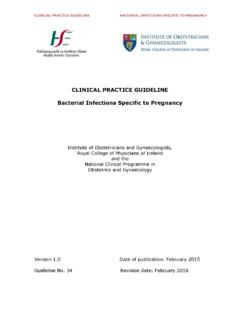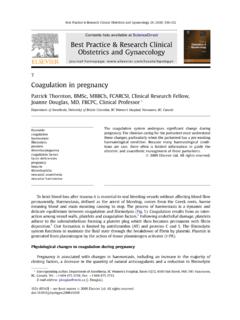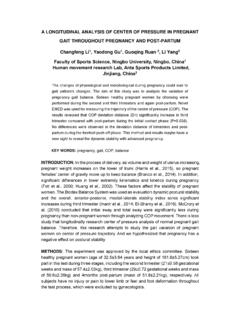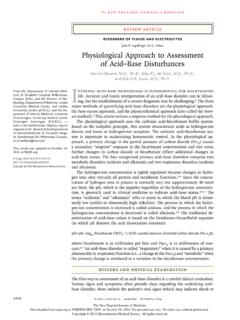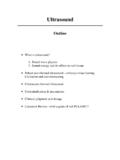Transcription of Lung function tests in different trimesters of …
1 Indian Journal of Basic and Applied Medical Research; December 2013: , Issue-1, 285 P ISSN: 2250-284X E ISSN :2250-2858 Original article: Lung function tests in different trimesters of pregnancy DR. , * Name of the Institute/college: Department of Physiology, Siddhartha Institute of Medical Sciences and Research Foundation, Chinnavutapalli , Andhra Pradesh , India *Corresponding author : Email id : ABSTRACT: Introduction: Pregnancy is associated with physiological changes in the control of breathing, in lung volumes, in the mechanics of respiration and in acid base balance. The static lung volume changes that occur during pregnancy rapidly normalize after delivery with decompression of the diaphragm and lungs. Our objective was to study the Lung Volume changes which occur in different trimesters of pregnancy using spirometry. Materials & Methods: The study consists of recording the Pulmonary function tests of 4 groups of female subjects including pregnant women of various phases of gestational period , 12 weeks (I trimester), 24 weeks (II trimester ) , 36 weeks ( III trimester) and control group of non pregnant women.
2 The different static lung function parameters measured in this study were Expiratory Reserve Volume (ERV), Tidal Volume (TV), Vital Capacity (VC), Residual Volume (RV) & Minute Volume (MV). Results: We observed a statistically significant decrease in Expiratory Reserve Volume, Residual Volume and a significant increase in Tidal Volume, Vital Capacity & Minute Volume in different trimesters of pregnancy. Conclusion: From the results of our study, it can be concluded that significant changes in pulmonary physiology occur during pregnancy which are necessary to meet the increased metabolic demands of the mother and fetus. Keywords: Expiratory Reserve Volume , Tidal Volume , Vital Capacity INRODUCTION: Pregnancy is characterized by sequence of dynamic physiological changes that impact on multiple organ system functions and is associated with various changes in pulmonary anatomy and physiology.
3 Three important changes in the configuration of the thorax that occur during pregnancy were an increase in the circumference of the lower chest wall (with increases in antero-posterior and the transverse diameters); elevation of the diaphragm (a cephalad displacement of appr-oximately 4 cm to 5 cm) and a 50% widening of the costal angle (1 -3). These changes peak around the 37th week of pregnancy and normalize within 6 months after delivery. Pulmonary function is affected by changes of the airway, thoracic cage, and respiratory drive. Additionally, capillary engor-gement throughout the respiratory tract results in mucosal edema and hyperemia (4,5). Multiple bioc-hemical alterations like increase in progesterone, estrogen, prostaglandins, corticosteroid and cyclic nucleotide levels occur concomitantly during the course of pregnancy.
4 The thoracic circumference increases about 6cm but not sufficiently to present a marked reduction in the Residual Volume of air in the lungs controlled by the elevated diaphragm. Diaphragmatic excursion is actually greater during pregnancy than during non pregnant state. At any stage of normal pregnancy, the Indian Journal of Basic and Applied Medical Research; December 2013: , Issue-1, 286 P ISSN: 2250-284X E ISSN :2250-2858 amount of oxygen delivered into the lungs, by the increase in Tidal Volume clearly exceeds the oxygen need imposed by pregnancy. Moreover the amount of hemoglobin in circulation increases as a consequence of the maternal arterio-venous oxygen difference. Pregnancy is associated with physiological changes in the control of breathing, in lung volumes, in the mechanics of respiration and in acid base balance.
5 Maternal respiratory alterations in turn affect the metabolism and well-being of the fetus through their influence on placental gas exchange. The most striking alteration in lung function is an increase in Minute Ventilation which increases by 36% by the eighth week of pregnancy ultimately reaching levels which are 50% above the non-pregnant need. This adjustment is required to satisfy the increase in oxygen consumption of 30-35% by the growing fetus. However the timing and magnitude of the increase in Minute Ventilation is in excess of the oxygen requirement for fetal development which may be due to the stimulatory effect of progesterone on the respiratory center. This expansion in Minute Ventilation leads to a slight decrease in alveolar PCO2 and lower PaCO2 from 38 torr to approximately 30 torr at term.
6 The kidney compensates metabolically by an increase in the excretion of bicarbonate partially affecting changes in the blood pH. Mild respiratory alkalosis occurs and the pH rises from to near term. The increase in ventilation occurs without an increase in respiratory rate and this is accomplished mainly by a rise in Tidal Volume from 500ml to 700 ml and this explains the frequent sighing observed in pregnant women. The physiological changes induced by pregnancy have been summarized by de Swiet (6) :Vital Capacity may be increased by about 100 to 200ml ; Inspiratory Capacity increases by about 300ml by late pregnancy; Expiratory Reserve Volume decreases from a total of 1300ml to 100ml ; Residual Volume decreases from a total of 1500ml to 1200ml ; Functional Residual Capacity (FRC), the sum of Expiratory Reserve Volume (ERV) and Residual Volume (RV), is reduced by about 500ml; Total Volume increases considerably from about 500-700ml ; Minute Ventilation increases by 40%.
7 , from L/min to a total of ; this is primarily due to increase in Tidal Volume (TV) because the respiratory rate remains unchanged. These changes are induced to help the increased supply of oxygen as basal oxygen consumption increase incrementally by 20-40 ml/minute every month in the second half of pregnancy. As a result, arterial PO2 falls very slightly, PCO2 averages 28 mm Hg, plasma pH is slightly alkaline at and bicarbonate decreases to about 20 meq/L. MATERIAL & METHODS: The study consists of recording the Pulmonary function tests in four groups of female subjects including pregnant women of various phases of gestational period 12 weeks, 24 weeks, 36 weeks and control group of non pregnant women of the child bearing age (20-40) , mainly lady doctors, nurses and lady medical students. The subjects considered for this study are with Hemoglobin more than 10 gm%.
8 The study was approved by the Institutional Ethical Committee. Informed consent was taken from the subjects. All the subjects were called for spirometric tracings in the afternoon between 3 to 5pm. (3 to 4 hrs after meal) in the post absorption stage in order to keep uniform conditions for recording the tests . All the subjects were given instructions and demonstration Indian Journal of Basic and Applied Medical Research; December 2013: , Issue-1, 287 P ISSN: 2250-284X E ISSN :2250-2858 with regard to performance of the tests . The tracings in the spirograph were taken after being fully satisfied. Two to three tracings were taken out of which the best is taken as final reading. The female subjects who are nonsmokers and are free from cardiovascular and respiratory disorders were grouped into five groups as: Group 1 - Female normal subjects aged 20-25 years; Group 2 - Pregnant subjects of first trimester gestational period aged 20-25 years; Group 3 - Pregnant subjects of second trimester gestational period aged 20-25 years ; Group 4 - Pregnant subjects of third trimester gestational period of age 20-25 years.
9 The different lung function parameters measured in this study include ERV, IRV,TV, VC,RV and MV. Statistical Analysis was done using Graph pad prism 6 Software. Unpaired t test was used to compare the mean value s. RESULTS: CONTROL MEAN SD 1ST trimester MEAN SD 2 NDtrimester MEAN SD 3RD trimester MEAN SD ERV in Litres TV in Litres VC L/min RV in Litres MV Litres/min Table 1 : Mean Value s of ERV, TV,VC, RV & MV in different trimester s of pregnancy. CONTROL MEAN SD 1ST TRIMESTER MEAN SD P-VALUE ERV ** TV < ** VC * RV < ** MV NS Table 2 : Comparison of Mean value s of different lung function parameters between control and I trimester pregnant women . Indian Journal of Basic and Applied Medical Research; December 2013: , Issue-1, 286 P ISSN: 2250-284X E ISSN :2250-2858 CONTROL MEAN SD IIND TRIMESTER MEAN SD P-VALUE ERV < ** TV < ** VC * RV < ** MV ** Table 3 : Comparison of Mean value s of different lung function parameters between control and II trimester pregnant women.
10 CONTROL MEAN SD IIIRD TRIMESTER MEAN SD P-VALUE ERV < ** TV < ** VC < ** RV < ** MV < ** Table 3. Comparison of Mean value s of different lung function parameters between control and III trimester pregnant women . When the mean Expiratory Reserve Volume (ERV) of control subjects is compared with mean Expiratory Reserve Volume (ERV) of the subjects in the I trimester pregnancy, a non significant decrease of is observed in subjects of I trimester subjects ( p value = ). In the same way, the mean Expiratory Reserve Volume (ERV) in the II trimester subjects has shown a statistically significant decrease of when compared with that of the control subjects (p value < ). The mean Expiratory Reserve Volume (ERV) in the III trimester subjects also has shown a statistically significant decrease of % as compared to the mean Expiratory Reserve (ERV) of the control subjects (p value < ).










